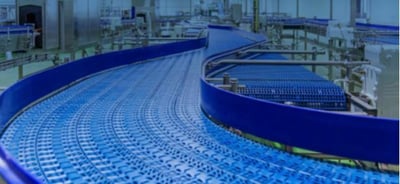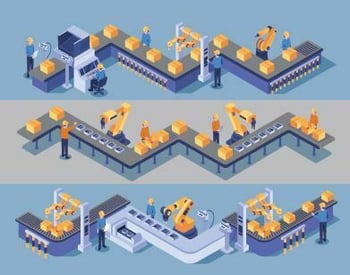Roadmap: How to Build Supply Chain Resiliency
Roadmap: How to Build Supply Chain Resiliency with JD Edwards

Here are six key functions that can be streamlined with automation as more companies bring their manufacturing operations back to the U.S. and build on supply chain resiliency
As companies restructure their supply chains in the aftermath of world events, most are focused on becoming faster, nimbler, and more resilient. Wanting to ward off significant disruptions while also future-proofing their supply chains against the next big disruption, 64% of U.S. manufacturers plan to bring some or all of their production to North America, according to a recent Thomas survey.
Thomas says survey respondents are also taking a bigger interest in automation, with 25% of them considering expanding their use of industrial automation to minimize future disruptions. Armed with a firsthand lesson in the dangers of extended, overseas supply chains, smart companies are automating and reshoring with the goal of developing shorter, closer supply chains that minimize exposure and risk. The most profound impact of these disruptions on American manufacturing has been to add a powerful new impetus behind repatriating all or parts of the supply chain back to the America. “There is now a widespread and transformational commitment to reshoring supply chains.”, according to Industry Week.
“This is the time for manufacturing companies to take stock of their operations, from production through the supply chain, and think critically about how they may be better prepared in the future.”
Manufacturing Automation
Transforming the Supply Chain Bringing manufacturing processes back to the U.S. is harder than it sounds. The comparatively high cost of domestic labor aside, companies also need new sources of supply, training on new processes, updated machinery—most of which was mothballed when production was sent to overseas providers 10-20 years ago.
Bringing manufacturing processes back to the U.S. is harder than it sounds. The comparatively high cost of domestic labor aside, companies also need new sources of supply, training on new processes, updated machinery—most of which was mothballed when production was sent to overseas providers 10-20 years ago.
The good news is that, while those processes were being handled offshore, technology was advancing at a rapid pace. Automation, the Internet of Things (IoT), manufacturing technology, and other advanced processes have all come a long way since the offshoring push took hold in the 1990s.
Fast-forward to 2020, and the company that watched its manufacturing come to a grinding halt during the pandemic due to a lack of raw materials has ample technology tools to its avail to make sure history doesn’t repeat itself.
As companies navigate the reshoring waters to develop their plans of action, automation is playing a key role in the process. In the absence of affordable labor, Industry 4.0 skills, and modern machinery, companies are turning to technology, IoT, robotics, JD Edwards Orchestrator, and automation for help. Here are six functions that technology can effectively manage for organizations that want resilient, reshored supply chains that can weather the next disruption by building supply chain resiliency with JD Edwards.
1. Dynamic forecasting. In times of uncertainty, business forecasts can change by the minute or the hour. Keeping up with these shifts is impossible using manual systems, but solutions like JD Edwards Orchestrator automate the forecasting process and help companies maintain accurate planning data that they can rely on. Even when the forecasts are changing by the minute, these automated solutions are working behind the scenes to minimize supply chain risk and support resilience in the most uncertain environments.
2. Capacity planning. When companies restarted their engines after these disruptions, one of the biggest transformations happened right on the manufacturing floor, where worker numbers had to be reduced in order to comply with new workplace distancing guidelines. For example, the company with one 8-hour shift and 10 employees had 80 hours of capacity. Should three of those workers fall ill or need to be furloughed, that capacity shrinks to 56 hours. By combining automation and capacity planning (i.e., using seven employees to work two shifts of six hours each to get 84 hours of capacity), companies can comply with the new regulations, keep their workforces healthy, and even reduce their payrolls while maintaining or even increasing capacity levels.
3. Meter readings. We’ve worked with customers whose meter reading activities required an employee and a guestimate as to how much liquid is left in a hydrogenated vegetable oil tank. As automation and technology made their way into the manufacturing environment, they’ve displaced many of these inefficient, manual processes. With more companies now focused on reshoring, these trends will surely continue. Food or chemical companies, for instance, can now captured the same liquid levels electronically, interface them with JDE via Orchestrator, and then adjust their cycle counts as needed. Orchestrator sends out email alerts when a vessel or container is empty—and/or posts the information to a dashboard—allowing the manager to act quickly (instead having to trudge down to the tank to see for him or herself).
4. Cross-functional training. As more companies reshore their operations, the need for cross-functional training will increase exponentially. Employees  working in a manufacturing facility will not only have to perform their core activities, but they’ll also have to issue work orders, manage work order completions, and manage functions like shipping, receiving, and picking. For example, employees who use scanners on the factory floor should also be trained on how to take corrective actions in JD Edwards (for when staff numbers are low). That means being able to log into JDE, navigate to the appropriate screen, and then make the necessary corrections. This and other cross-functional capabilities will become even more important as companies work to create more resilient, risk-averse supply chains.
working in a manufacturing facility will not only have to perform their core activities, but they’ll also have to issue work orders, manage work order completions, and manage functions like shipping, receiving, and picking. For example, employees who use scanners on the factory floor should also be trained on how to take corrective actions in JD Edwards (for when staff numbers are low). That means being able to log into JDE, navigate to the appropriate screen, and then make the necessary corrections. This and other cross-functional capabilities will become even more important as companies work to create more resilient, risk-averse supply chains.
5. Chain of approvals. This is an area where JDE Orchestrator can take over and manage what in the past may have been a largely manual process of approvals, paper-shuffling, and delays. With automation, the same approvals, engineering changes, change requests, and change orders can be directed through the desired approval routes. Once the design engineering approvers receive emails, they launch JDE, approve the changes, and then automatically generate an email notification for the next department (i.e., manufacturing). From there, the system creates a distribution list for multiple levels—a major “win” in a world where not everyone is working in the same building. As part of the chain of approvals, the system creates watchlists and notifications via email/SMS for critical items, clients, and suppliers, and then shares the important watchlists in a timely manner, building on supply chain resiliency
6. Material Requirement Planning (MRP) performance. As they reshore their supply chains and manufacturing activities, U.S. companies are also going to need advanced systems to plan their purchasing and production activities. The MRP systems also create POs and production orders that align with customer commitments. In some cases, a simple warning that the “MRP is taking six hours,” is enough to help a plant manager quickly correct the problem (e.g., thousands of unused locations or POs that have been open for months or years) and get things back on track. Recently, for example, GSI worked with a company that had 65,000 warning messages in JDE that were taking 45 minutes to process and impacting MRP performance.
The Only Certainty is Uncertainty
As the reshoring trend continues, the push to automate more business and manufacturing processes will continue, as companies look to build supply chain resiliency. Whether it’s being driven by the need to maintain social distancing in the workplace, reduce supply chain risk, compensate for a lack of workforce skills, or some other reason, automation’s role will be particularly prominent in the manufacturing environment. “This is the time for manufacturing companies to take stock of their operations, from production through the supply chain, and think critically about how they may be better prepared in the future,” Manufacturing Automation reports. “It’s kind of like a new world order. The only certainty is uncertainty.”
GSI, Inc.
GSI, Inc. (GetGSI.com) specializes in providing a broad spectrum of business, functional, and technical consulting services for Oracle JD Edwards, Oracle NetSuite, Oracle Cloud, Salesforce, ServiceNow, BMC, and other enterprise applications. We also offer an extensive array of cloud/hosting solutions for Oracle Cloud, Amazon Web Services (AWS), Microsoft Azure, Google Cloud, and private cloud. GSI’s comprehensive suite of solutions includes AppCare, a 24/7 managed service; GENIUS AI, an Application Intelligence Platform (AIP) for creating application health and user experience monitors; GENISYS, a solution for modeling, measuring, and maximizing system performance; gShield, a comprehensive security solution; RapidApproval®, a Salesforce AppExchange solution for streamlining the approval request process; RapidReconciler®, its inventory reconciliation software, and JDE Cloud9, a complete cloud-based hosted service. GSI consulting services are backed by its signature 100 percent guarantee. Founded in 2004, the rapidly growing company is headquartered in Atlanta with locations nationwide. GSI, Inc. has been named to Inc. Magazine’s Inc.5000 list of fastest-growing companies for two consecutive years.
FOR MORE INFORMATION ON JD EDWARDS 9.2.4 OR GSI'S JD EDWARDS SERVICE OFFERINGS
CONTACT US TODAY
FOR MORE INFORMATION ON JDE 9.2.4 OR GSI'S JD EDWARDS SERVICES
